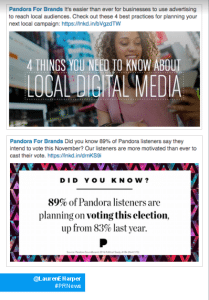
Some people treat their LinkedIn profile like a Ronco rotisserie oven: They set it and forget it, until they need to find a new job. Quietly, though, the platform has become a go-to for business executives. And it’s grown. LinkedIn said Apr. 24 it has 500 million members. That’s up from August, when it said it had 450 million members. When Microsoft acquired it for $26 billion in 2016, some questioned LinkedIn’s growth prospects. LinkedIn also said last week its members reside in 200 countries and can peruse 10 million jobs and 9 million companies. Still wondering about growth?
This announcement prompted us to wonder about how brands can tap into the LinkedIn base with their messages. We asked a brand communicator as well as a LinkedIn executive about best practices for brands trying to build engagement and market services on the platform.

Senior Manager, B2B Content &
Social Media
Marketing,
Pandora
Goals First and Business: At barely 15 years old, LinkedIn’s a relatively new platform. Yet Lauren Harper, senior manager for B2B content and social marketing at Pandora, advocates taking a traditional approach to building a brand’s presence on LinkedIn. “Start with a mission statement,” she says. “Answer questions like, ‘Why is your brand on LinkedIn? Who are you trying to talk to?’” Remember to bring everything back to business goals. “Ask, ‘What are my business goals and how will being on LinkedIn help me?’”
To distinguish Pandora’s outreach to advertisers from other parts of its business, the brand has several show pages on Pandora corresponding to parts of the business. Harper oversees content for the Pandora for Brands show page. Prior to developing these additional pages, Harper says, various business units competed for space and timing was an issue.
 Thought Leadership: Pandora, Harper says, attracts potential advertisers by showcasing thought leadership on LinkedIn. Bucking conventional wisdom, it emphasizes storytelling over sales when creating content for LinkedIn. “People want to read stories” as opposed to content that says “buy ads on Pandora,” she says. Still, Pandora’s content “is aligned with our business goals...it’s a subtle sale.” Stories that do well for Pandora include those about advertisers that are mounting creative and successful campaigns, she says.
Thought Leadership: Pandora, Harper says, attracts potential advertisers by showcasing thought leadership on LinkedIn. Bucking conventional wisdom, it emphasizes storytelling over sales when creating content for LinkedIn. “People want to read stories” as opposed to content that says “buy ads on Pandora,” she says. Still, Pandora’s content “is aligned with our business goals...it’s a subtle sale.” Stories that do well for Pandora include those about advertisers that are mounting creative and successful campaigns, she says.
More of her tips for thought leadership content:
1. Be informative: “We want to provide content that will make the reader better [informed]…and share content they can’t find elsewhere.”
2. Think like a publisher: Post content in a steady and regular cadence.
3. Know your audience and put it first, sales second: This is a variation on putting storytelling first and sales second. To learn about your audience, Harper recommends, “Test, test, test and then test more” to see who likes and engages with your content. Create buyer personas and map content back to them. Some of your audience might be senior executives, others are juniors, she says. Provide content for both.
CONTACT: @LaurenEHarper
Advice from LinkedIn
1. Writer’s Block: What should my executive write about on LinkedIn is one of the most common questions, says LinkedIn’s senior manager, member marketing and communications, Blair Decembrele. Her answer: It depends on your brand’s goals and its narrative.
2. People Who Need People: Decembrele urges brands to reveal their human side through posts on LinkedIn. “People want to hear from people, not companies,” she says.
3. What Resonates? Finding executives to write LinkedIn content is only the first step.Decembrele says little about how LinkedIn’s algorithms determine placement, but urges content creators to spend time on compelling headlines and make sure they’re “super clear.” Compelling images are critical, too. “9 out of 10 times” posts fail because they’re not authentic, she says.
